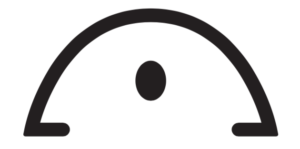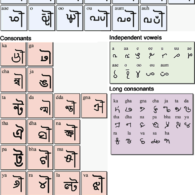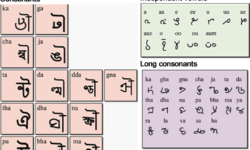Profile
Kolam is one of nearly twenty scripts created by Dr. Prasanna Sree for indigenous and minority groups, mostly in Andhra Pradesh. In each case, the design of the script reflects some iconic feature of the culture of that linguistic community. She writes:Kolam is a Dravidian language spoken by about 200,000 people in the Indian states of Maharashtra, Andhra Pradesh and Madhya Pradesh. The Kolam tribal community uses the beautiful language of Kolami, also known as Kolami, Kolamboli, Kolamy, Kolmi or Kulme. A handful of these Kolam tribes speak other languages like Marathi, Telugu or Gondi quite fluently.
The Kolam call themselves Kolvar: Kola means “stick” or “bamboo” in their language. Their name probably derives from their livelihood of making baskets, wattles and winnowing fans from bamboo.
The Kolam tribes of Madhya Pradesh are also identified by different names like Kolamboli, Kulme and Kolmi. The main concentration of this tribe is on the plains and in the mountainous region. These tribal groups are reckoned as scheduled tribes and apart from Madhya Pradesh they reside in some parts of Maharashtra and Andhra Pradesh. The Kolam people are divided in different clans like Chal Deve, Pach Deve, Saha Deve, and Sat Deve. Marriages between the same clans are not permissible. The Kolams use the name of their clans as their surnames.
The early history of this tribal group says that the Gond tribes regarded the Kolam tribes as their priests in the 12th century.
The societal structure of the Kolma tribal community follows the norms and practices of any of the other tribal communities of the Indian subcontinent. Some of them also consider themselves as the descendants of Pandavas of the Mahabharata.
Due to their close affinity with the Gond tribes, the culture of the Kolam tribes resembles them in the fields of rituals and ceremonies. The people of this community take up agriculture as their major occupation. Some of them are also engaged in forest works, hunting, and making wooden articles.
The Kolam tribes have a preference for homemade medicines. They adapt to cultivation and farming, and sometimes shifting cultivation is also practiced. Some of the members of this Kolam tribal community also work as laborers in lieu of daily wages. Other occupations include animal husbandry, hunting and also food gathering. The Kolam food gatherers mainly produce various producers from the forest areas and also sell them in the markets.
The Kolam script is based on Kolam agricultural practices. The Kolam are very neat, softly-spoken and environmentally conscious, and as such they make wide use of bamboo in their daily lives. The vertical line in their script also suggests the crowbar, one of their most important implements.
You can help support our research, education and advocacy work. Please consider making a donation today.


